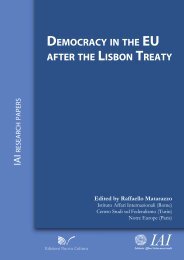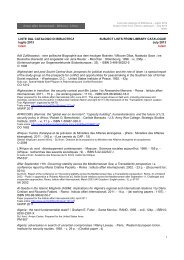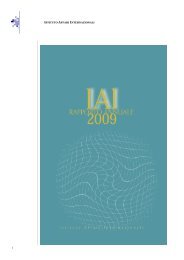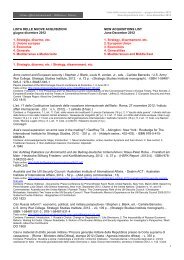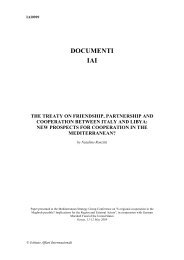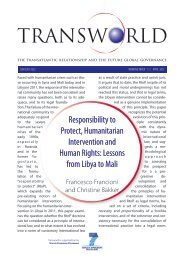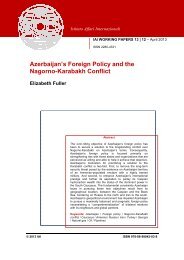La minaccia NBCR - Istituto Affari Internazionali
La minaccia NBCR - Istituto Affari Internazionali
La minaccia NBCR - Istituto Affari Internazionali
Create successful ePaper yourself
Turn your PDF publications into a flip-book with our unique Google optimized e-Paper software.
The institutions which, in different ways, deal with the prevention and management of the<br />
CBRN threat include the Presidency of the Council of the Ministers, the National Security<br />
Authority, Civil Protection Department, Ministry of the Interior (in particular, the Fire<br />
brigade and Police forces), Ministry of Health, Ministry of Defence, Ministry of<br />
Infrastructures, Ministry of Foreign Affairs, Border and Customs Police (which responds to<br />
the Ministry for the Economy and Finance), Ministry for Agriculture and Forests, as well as<br />
numerous local and peripheral agencies (in particular, prefectures).<br />
The nature of CBRN threats calls into question traditional institutional competences, with<br />
new interactions and overlaps between the various components of this complex system. Since<br />
the fragmentation of responsibility can invalidate the efficacy and efficiency of the response,<br />
this complexity has to be managed by means of a clear institutional and normative set-up for<br />
CBRN threats. Today, such a set-up is lacking as there is no political-institutional strategy.<br />
This has to be developed with a reconfiguration of the national security system.<br />
The hypothesis developed in the research suggests a support structure to be headquartered in<br />
the Presidency of the Council of the Ministers, which would be the decision-making base at<br />
national level, able permanently to draw upon the capabilities of the various administrations<br />
and competent agencies (Conclusion).<br />
Furthermore, we suggest setting up a Council of the Ministers for Emergencies (Consiglio<br />
dei Ministri per le Emergenze – CME), composed of the Prime Minister and the Ministers of<br />
the Interior, Defence, Foreign Affairs and the Economy and Finance. The Prime Minister<br />
could invite to the meetings other Ministers, whose participation he/she considers useful<br />
depending on the nature of the event and the decisions to be taken. The multiplicity of<br />
agencies that could be involved in an emergency would result in a “call to arms” of numerous<br />
central and local administrations, for which the decision-making at the general level or in<br />
particularly serious cases would be coordinated by the CME.<br />
Moreover, the Prime Minister would be flanked by an Undersecretary to the Prime Minister<br />
expressly delegated for the management of emergencies (Sottosegretario alla Presidenza del<br />
Consiglio delegato per la gestione delle Emergenze - SSE), who would support or, if need be,<br />
replace him/her. This would ensure that there is a strongly specialized figure in the<br />
Government able to provide the necessary continuity in management of interventions.<br />
X





